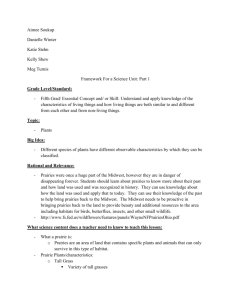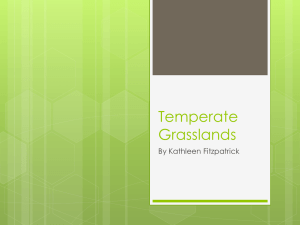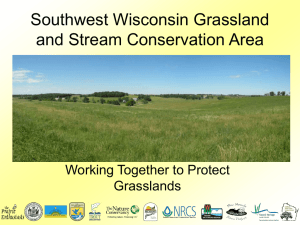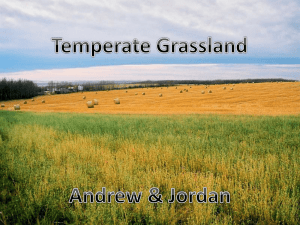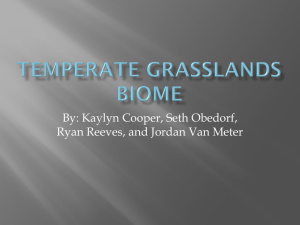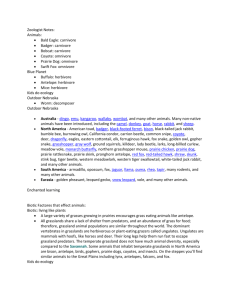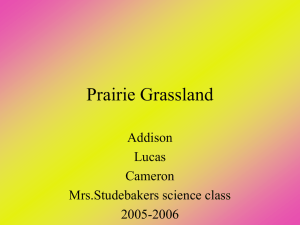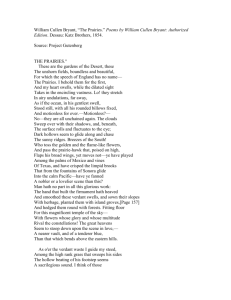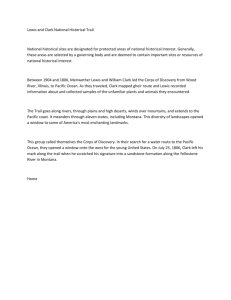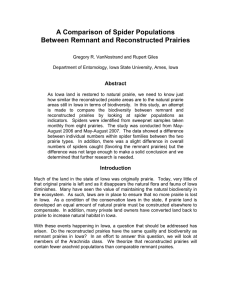What Are the Impacts of Humans on Grassland
advertisement
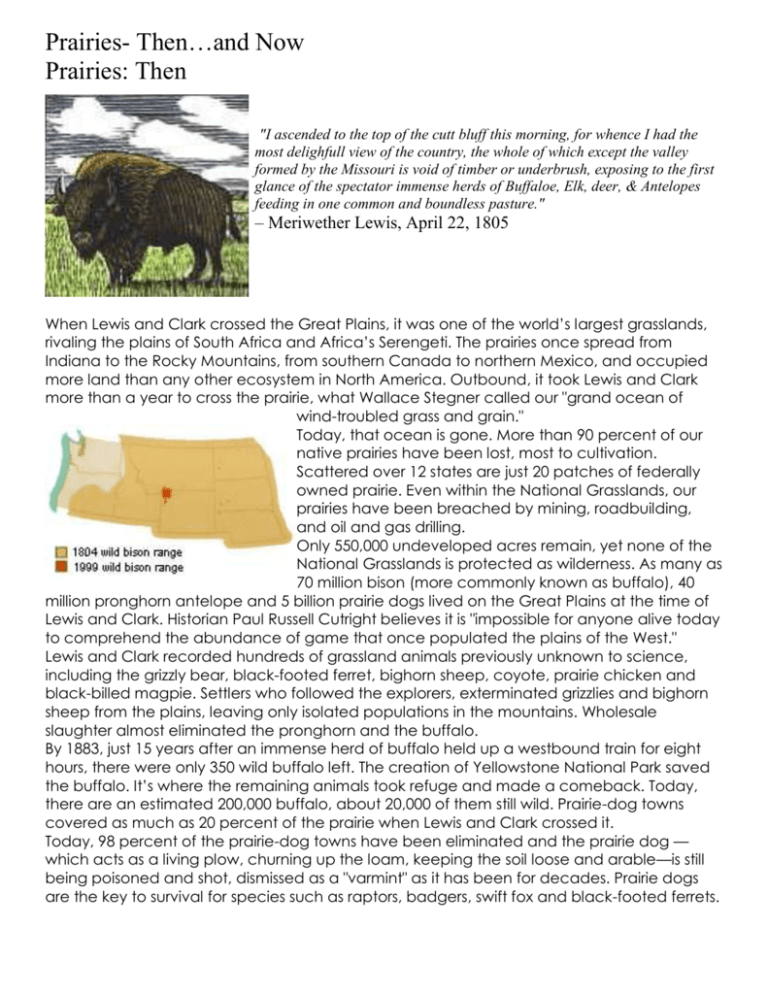
Prairies- Then…and Now Prairies: Then "I ascended to the top of the cutt bluff this morning, for whence I had the most delighfull view of the country, the whole of which except the valley formed by the Missouri is void of timber or underbrush, exposing to the first glance of the spectator immense herds of Buffaloe, Elk, deer, & Antelopes feeding in one common and boundless pasture." – Meriwether Lewis, April 22, 1805 When Lewis and Clark crossed the Great Plains, it was one of the world’s largest grasslands, rivaling the plains of South Africa and Africa’s Serengeti. The prairies once spread from Indiana to the Rocky Mountains, from southern Canada to northern Mexico, and occupied more land than any other ecosystem in North America. Outbound, it took Lewis and Clark more than a year to cross the prairie, what Wallace Stegner called our "grand ocean of wind-troubled grass and grain." Today, that ocean is gone. More than 90 percent of our native prairies have been lost, most to cultivation. Scattered over 12 states are just 20 patches of federally owned prairie. Even within the National Grasslands, our prairies have been breached by mining, roadbuilding, and oil and gas drilling. Only 550,000 undeveloped acres remain, yet none of the National Grasslands is protected as wilderness. As many as 70 million bison (more commonly known as buffalo), 40 million pronghorn antelope and 5 billion prairie dogs lived on the Great Plains at the time of Lewis and Clark. Historian Paul Russell Cutright believes it is "impossible for anyone alive today to comprehend the abundance of game that once populated the plains of the West." Lewis and Clark recorded hundreds of grassland animals previously unknown to science, including the grizzly bear, black-footed ferret, bighorn sheep, coyote, prairie chicken and black-billed magpie. Settlers who followed the explorers, exterminated grizzlies and bighorn sheep from the plains, leaving only isolated populations in the mountains. Wholesale slaughter almost eliminated the pronghorn and the buffalo. By 1883, just 15 years after an immense herd of buffalo held up a westbound train for eight hours, there were only 350 wild buffalo left. The creation of Yellowstone National Park saved the buffalo. It’s where the remaining animals took refuge and made a comeback. Today, there are an estimated 200,000 buffalo, about 20,000 of them still wild. Prairie-dog towns covered as much as 20 percent of the prairie when Lewis and Clark crossed it. Today, 98 percent of the prairie-dog towns have been eliminated and the prairie dog — which acts as a living plow, churning up the loam, keeping the soil loose and arable—is still being poisoned and shot, dismissed as a "varmint" as it has been for decades. Prairie dogs are the key to survival for species such as raptors, badgers, swift fox and black-footed ferrets. Prairies… Now What Are the Impacts of Humans on Grassland Biomes? by Kevin Carr, Demand Media Human population growth has a major impact on the different biomes of the Earth. Grassland biomes, characterized by large areas of land where grasses are the primary form of plant life, are affected by expanding human civilization in particular ways. The grazing land for many species of animals, which in turn provide a food source for larger predators, is often at risk. Urban Development The biggest impact that humans have on grasslands is by developing open areas for farming or urban development. Such development is prevalent because grasslands are generally level areas with little need for major work to develop the land. The development of land drives animals away from populated areas and changes the conditions of the environment. Farming When grasslands are converted into cropland, it reduces the food source for many wild animals. In this case, the animals are considered pests by the farmers when they feed on the crops. This can lead to migration or possibly the starvation of the animals. Not only does the conversion of land into crops change the ecosystem, but so does the farming of livestock. If livestock are allowed to graze in areas where wild animals live, they compete over the food source and can deplete it. This overgrazing is a problem especially in the drier grassland regions, where the grasses resources can be depleted. The land can also be plowed too much, stripping the nutrients from the soil. Salts from irrigation waters can also damage the ground, resulting in the blowing away of the dry soil. This is the process that created the Dust Bowl in the American west in the 1930s and continues to cause major dust storms. Hunting Hunting has had and continues to have a serious impact on the biome. The American bison population was devastated by the European settlers and almost became extinct due to overhunting for the fur and meat. Poachers are likewise killing rhinoceroses for their tusks and elephants for their ivory in Africa. Global Warming As the Earth's climate changes in response to human involvement, the grasslands become vulnerable. Climate change can cause ecological succession, in which the ecosystem of an area develops into another. Changing temperatures, weather patterns and water availability can throw an area of grassland out of balance and change it forever. Fires Because grasslands can be found in drier climates, the plant life is susceptible to fires. Wildfires occur as a natural process within an ecosystem and play a critical role in replenishing the land. However, fires tend to originate more frequently near human populations, particularly in drier months. Positive Impacts Humans do not have only a negative impact on grasslands. There are some that do their part to preserve the land and restore it. National parks have been developed around grasslands and some organizations replant areas of depleted grassland. Governments have enacted laws against the hunting of endangered animals. In particular, the U.S. National Parks Service has preserved land to foster the American bison population. While poaching still exists in many areas, there are efforts to stop it. Name: _____________________________________________ Period: ________ Prairies – Then and Now 1. Describe what American explorers, Lewis and Clark, observed when they first viewed the American Prairie in 1805. ________________________ _____________________________________________________________________ _____________________________________________________________________ __________________________________________________________________________________________ __________________________________________________________________________________________ 2. What was the dominant type of plant growing in the prairies? ___________________________ __________________________________________________________________________________________ __________________________________________________________________________________________ 3. Why is there no mention of trees growing? Can you think of a reason why they would not be able to grow? ________________________________________________________________________ __________________________________________________________________________________________ 4. What were some animals that roamed the prairies in great numbers? ____________________ __________________________________________________________________________________________ __________________________________________________________________________________________ 5. Explain the changes that have affected the bison population over the last 200 years. What caused the population decrease? What role has the government had in restoring the population? _____________________________________________________________________________ __________________________________________________________________________________________ __________________________________________________________________________________________ __________________________________________________________________________________________ __________________________________________________________________________________________ __________________________________________________________________________________________ 6. More than 90% of our native prairies have been converted into farmland. Describe an example (in detail) of how this change has greatly impacted the prairie region. __________________________________________________________________________________________ __________________________________________________________________________________________ __________________________________________________________________________________________ __________________________________________________________________________________________ __________________________________________________________________________________________ 7. What do you think historian Paul Russell Cutright meant by “it is impossible for anyone alive today to comprehend the abundance of game that once populated the plains of the West?”___________________________________________________________________________________ __________________________________________________________________________________________ __________________________________________________________________________________________ __________________________________________________________________________________________ __________________________________________________________________________________________ 8. REFLECTION: If Lewis and Clark were to revisit the prairies today, what would be the most significant (important) change they would observe? How do you think they would feel about this change? Explain in detail. _______________________________________________________________ __________________________________________________________________________________________ __________________________________________________________________________________________ __________________________________________________________________________________________ __________________________________________________________________________________________ __________________________________________________________________________________________ __________________________________________________________________________________________

